4 Ways a Portable Pedestrian Ramp Makes the Community more Accessible
Everyone wants a more accessible community. But the reality is that all communities have unique obstacles that create barriers for those who do not have the same mobility abilities as others. For example, disturbances to safe routes, such as sidewalk construction, pose an even greater challenge for individuals with mobility disabilities.
While all municipalities must provide safe pathways accessible for all people when streets are repaired or reconstructed, quickly implementing a solution can become a challenge.
Portable pedestrian ramps provide an accessible way for pedestrians to traverse a city’s sidewalks that otherwise would be restricted, limiting their ability to access their community.
What is the Americans with Disabilities Act?
Signed into law in 1990, the Americans with Disabilities Act (ADA) protects persons with disabilities from discrimination and ensures equal employment opportunities, State and local government services, public accommodations and commercial facilities, transportation and telecommunications.
The federal civil rights law establishes comprehensive standards for the accessible design and construction of physical features in buildings, transportation vehicles and facilities, requiring one to provide reasonable accommodations for people with disabilities to access the area. A wheelchair ramp is an example of a common accommodation for people with a mobility disability.
Community Accessibility
The CDC defines a mobility disability as serious difficulty walking or climbing stairs, including people who use wheelchairs or have trouble with balance; they estimate that more than 9 million Americans have a mobility disability. The Blind and Visually Impaired (BVI), in addition to other impairments such as hearing loss and chronic health conditions such as arthritis, diabetes and heart disease, can also have significant difficulties with their mobility.
Therefore, accessibility is critical to the safety and well-being of all community members, and portable pedestrian ramps can be the solution by creating a continuous path for pedestrians to overcome obstructions and easily travel around the area.
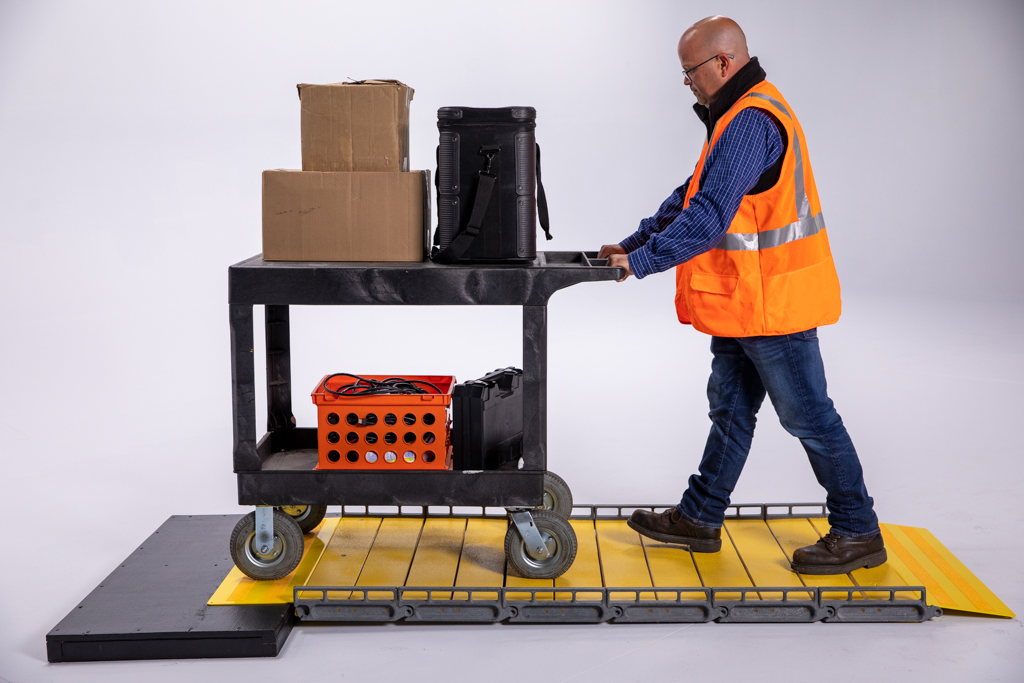
What are Portable Pedestrian Ramps?
Ramps create a traversable platform that provides a safe and accessible way to overcome elevation changes. They allow people with disabilities or others with limited mobility to access buildings, facilities and pathways that would otherwise be inaccessible.
Portable pedestrian ramps are quick to set up, providing an ideal solution when sidewalks require repair and need to be closed for reconstruction. Instead of disturbing the continuous pathway for pedestrians and posing an additional problem for those with mobility challenges, a portable pedestrian ramp provides a safe and convenient way to cross streets or walkways without disrupting traffic flow or obstructing other pedestrians.
Currently, the sidewalks and ramps used during closures are often not up to par for ADA standards. While an official permit must be issued to close a sidewalk, many permit officials need to be made aware that products such as portable pedestrian ramps exist.
In order to help make our community more accessible for everyone, here are some ways portable pedestrian ramps can help.
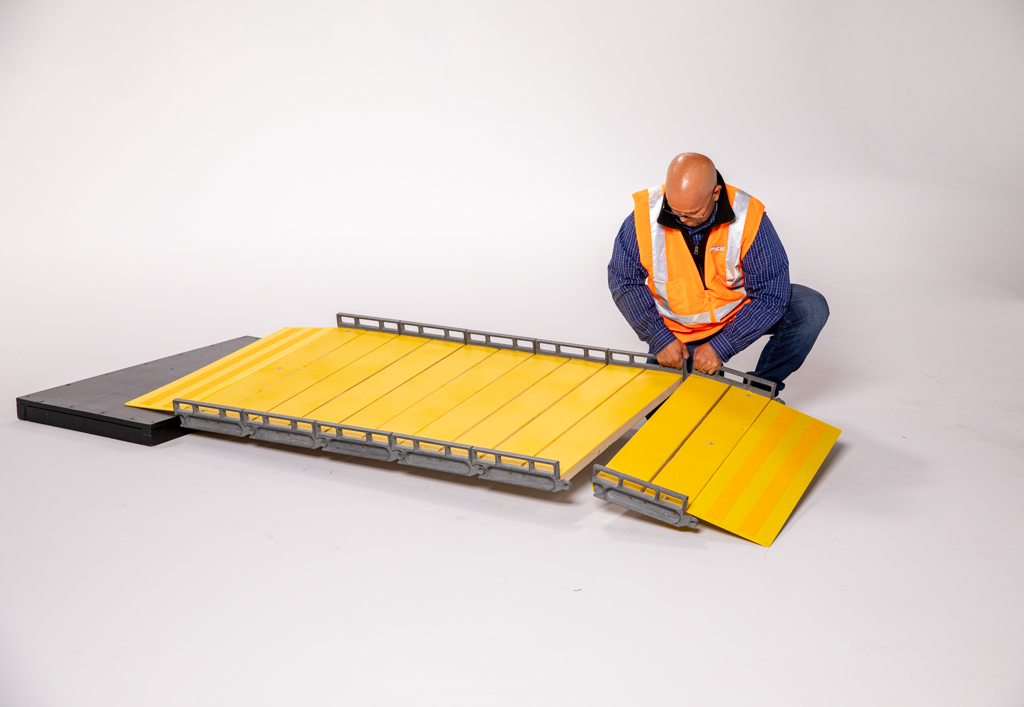
1. Uninterrupted Accessibility
The ADA is a civil rights law that ensures people with physical mobility disabilities have the same access to the community as everyone else, requiring businesses and organizations to provide reasonable accommodations for people with disabilities. A portable pedestrian ramp is one of those reasonable accommodations.
If you have ever walked with a cane, crutches or walker, you know that curbs are not just an annoyance but can be downright dangerous for people with mobility disabilities. While curbs separate the roadway and the pedestrian pathway, they can also pose a problem for people with disabilities and mobility issues. A ramp is a way to fix the challenges of curbs.
The ADA Accessibility Guidelines (ADAAG) define curb ramps as "sloped surfaces designed to facilitate access for persons with disabilities." Ramps allow for a continuous path for pedestrians to overcome vertical obstructions like curbs as the pedestrian without deviating around the sidewalk closure or walkway obstruction. In addition to complying with ADAAG, there are other benefits to installing curb ramps in your community.
2. Safety
When building new streets or rerouting old ones, pathways can become confusing for pedestrians who use mobility devices or have visual impairments, especially when signage is sparse or nonexistent. People can make unsafe decisions while trying to navigate path changes, often leading them to long detours away from their destinations. People may try to go around an area if they don't know where to go, possibly ending up in the street. When you have a portable pedestrian ramp in place, you can direct them where they need to go and keep them safe from traffic.
The primary purpose of this kind of ramp is to help pedestrians get over any height difference between sidewalk and street, whether the cause is from an event, construction project or other path change that lacks a permanent ramp.
Additional features of portable pedestrian ramps that increase pedestrian safety include:
Slip resistance.
Water drainage to prevent pooling.
Visual cues to ensure visibility and handrail accommodations.
3. City Walkability
City walkability is the ease of walking through a city and the pleasantness of that experience. As more people move to cities, walkable urban places are increasingly in demand. A city with high walkability is one where it's easy to get around without a vehicle or other transportation.
Walking is an essential mode of transportation in our cities, but planners and decision-makers often overlook it. As a result, many places have streets that are difficult to walk on, making them inaccessible to people who are elderly or disabled or those with young children.
One of the most important ways to create a walkable city is by adding curb cuts and ramps at intersections. Curb cuts are sloped cuts into sidewalks that allow wheelchairs and other mobility devices to pass over sidewalks without having to go onto the street. But when plans fail to include curb cuts, ramps need to be introduced.
Ramps reduce barriers to travel and increase mobility for everyone. Ramps help ensure that all community members can access goods and services within their communities and employment opportunities. When streets are built for cars without considering how people get around on foot, it can be difficult for pedestrians to get around safely and efficiently.
4. Construction Zones
Sidewalks and streets require regular maintenance to keep the routes safe, but repairs create their own challenges. Construction work zones can be hazardous, especially for those with mobility issues. Temporary pathways through these zones may be sloping and uneven, making it difficult for people with disabilities to navigate them.
A portable pedestrian ramp is a temporary solution for short-duration job sites, creating a convenient way to make construction sites accessible to all. They're lightweight and portable, so they can be set up quickly and removed easily once they're no longer needed.
5. Portability keeps costs low
The portability of pedestrian ramps keeps costs low – thanks to their design that makes deployment, breakdown and storage quick and easy. Their light weight means heavy lifting equipment and skilled labor is unnecessary - just basic training in construction is needed to pick up and move.
Additionally, this makes them ideal for communities with multiple locations needing temporary solutions while they work on making those areas permanently accessible. You can reuse ramps at any site necessary so the community can quickly finish the project and move on to the next.
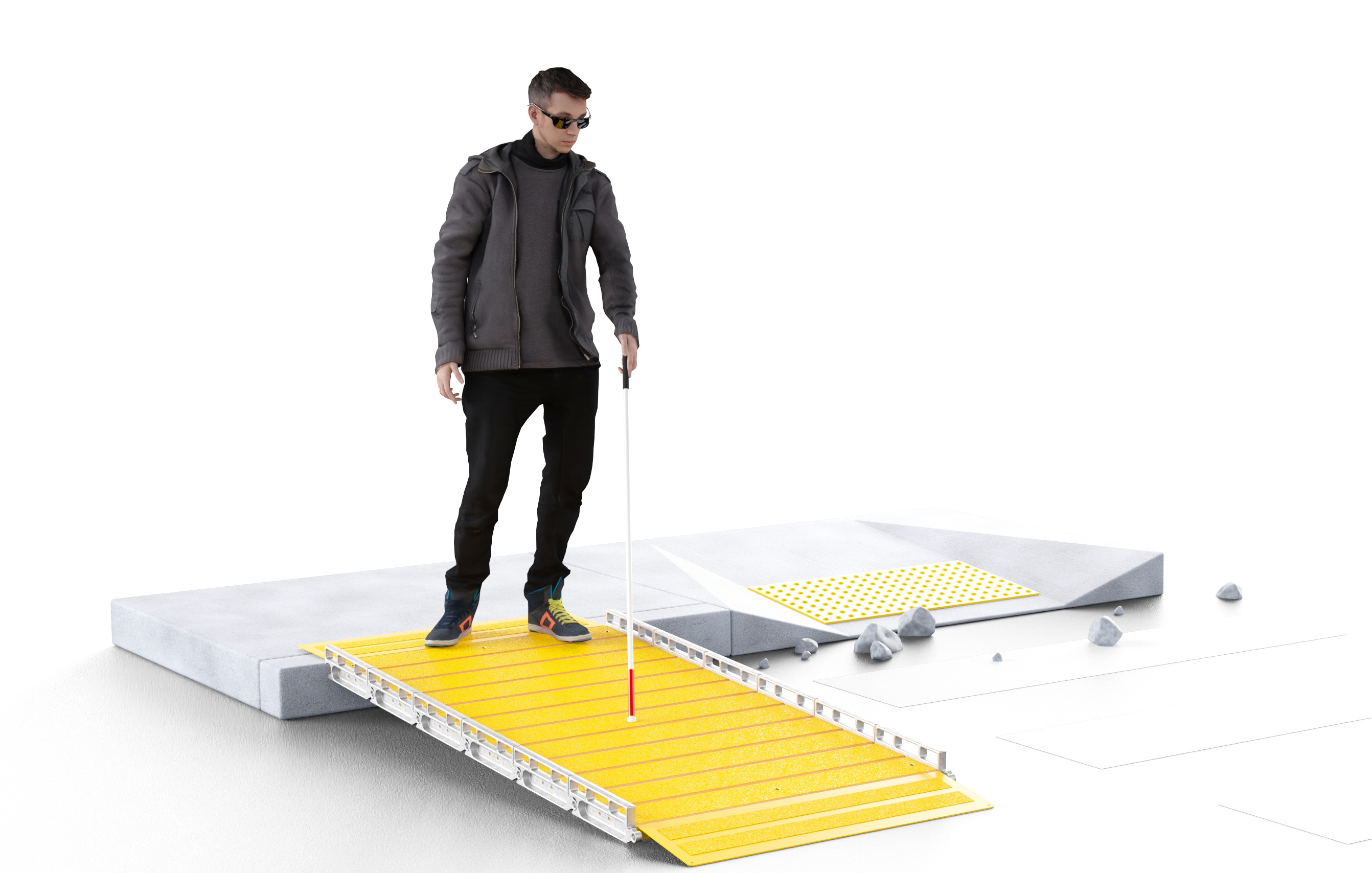
An Accessible Community
Portable pedestrian ramps make accessibility a reality for those with physical mobility disabilities by creating convenient pathways that open up access to their entire community. It's a simple concept that can significantly impact how people of all abilities can safely move throughout the city. Above all, portable pedestrian ramps are safe tools that can be used in various situations, making them as versatile as they are convenient. With these tools readily available, municipalities can help provide a more accessible community, one ramp at a time.
Portable pedestrian ramps provide an accessible way for pedestrians to traverse a city’s sidewalks that otherwise would be restricted, limiting their ability to access their community.
What is the Americans with Disabilities Act?
Signed into law in 1990, the Americans with Disabilities Act (ADA) protects persons with disabilities from discrimination and ensures equal employment opportunities, State and local government services, public accommodations and commercial facilities, transportation and telecommunications.
The federal civil rights law establishes comprehensive standards for the accessible design and construction of physical features in buildings, transportation vehicles and facilities, requiring one to provide reasonable accommodations for people with disabilities to access the area. A wheelchair ramp is an example of a common accommodation for people with a mobility disability.
Community Accessibility
The CDC defines a mobility disability as serious difficulty walking or climbing stairs, including people who use wheelchairs or have trouble with balance; they estimate that more than 9 million Americans have a mobility disability. The Blind and Visually Impaired (BVI), in addition to other impairments such as hearing loss and chronic health conditions such as arthritis, diabetes and heart disease, can also have significant difficulties with their mobility.
Therefore, accessibility is critical to the safety and well-being of all community members, and portable pedestrian ramps can be the solution by creating a continuous path for pedestrians to overcome obstructions and easily travel around the area.

What are Portable Pedestrian Ramps?
Ramps create a traversable platform that provides a safe and accessible way to overcome elevation changes. They allow people with disabilities or others with limited mobility to access buildings, facilities and pathways that would otherwise be inaccessible.
Portable pedestrian ramps are quick to set up, providing an ideal solution when sidewalks require repair and need to be closed for reconstruction. Instead of disturbing the continuous pathway for pedestrians and posing an additional problem for those with mobility challenges, a portable pedestrian ramp provides a safe and convenient way to cross streets or walkways without disrupting traffic flow or obstructing other pedestrians.
Currently, the sidewalks and ramps used during closures are often not up to par for ADA standards. While an official permit must be issued to close a sidewalk, many permit officials need to be made aware that products such as portable pedestrian ramps exist.
In order to help make our community more accessible for everyone, here are some ways portable pedestrian ramps can help.

1. Uninterrupted Accessibility
The ADA is a civil rights law that ensures people with physical mobility disabilities have the same access to the community as everyone else, requiring businesses and organizations to provide reasonable accommodations for people with disabilities. A portable pedestrian ramp is one of those reasonable accommodations.
If you have ever walked with a cane, crutches or walker, you know that curbs are not just an annoyance but can be downright dangerous for people with mobility disabilities. While curbs separate the roadway and the pedestrian pathway, they can also pose a problem for people with disabilities and mobility issues. A ramp is a way to fix the challenges of curbs.
The ADA Accessibility Guidelines (ADAAG) define curb ramps as "sloped surfaces designed to facilitate access for persons with disabilities." Ramps allow for a continuous path for pedestrians to overcome vertical obstructions like curbs as the pedestrian without deviating around the sidewalk closure or walkway obstruction. In addition to complying with ADAAG, there are other benefits to installing curb ramps in your community.
2. Safety
When building new streets or rerouting old ones, pathways can become confusing for pedestrians who use mobility devices or have visual impairments, especially when signage is sparse or nonexistent. People can make unsafe decisions while trying to navigate path changes, often leading them to long detours away from their destinations. People may try to go around an area if they don't know where to go, possibly ending up in the street. When you have a portable pedestrian ramp in place, you can direct them where they need to go and keep them safe from traffic.
The primary purpose of this kind of ramp is to help pedestrians get over any height difference between sidewalk and street, whether the cause is from an event, construction project or other path change that lacks a permanent ramp.
Additional features of portable pedestrian ramps that increase pedestrian safety include:
Slip resistance.
Water drainage to prevent pooling.
Visual cues to ensure visibility and handrail accommodations.
3. City Walkability
City walkability is the ease of walking through a city and the pleasantness of that experience. As more people move to cities, walkable urban places are increasingly in demand. A city with high walkability is one where it's easy to get around without a vehicle or other transportation.
Walking is an essential mode of transportation in our cities, but planners and decision-makers often overlook it. As a result, many places have streets that are difficult to walk on, making them inaccessible to people who are elderly or disabled or those with young children.
One of the most important ways to create a walkable city is by adding curb cuts and ramps at intersections. Curb cuts are sloped cuts into sidewalks that allow wheelchairs and other mobility devices to pass over sidewalks without having to go onto the street. But when plans fail to include curb cuts, ramps need to be introduced.
Ramps reduce barriers to travel and increase mobility for everyone. Ramps help ensure that all community members can access goods and services within their communities and employment opportunities. When streets are built for cars without considering how people get around on foot, it can be difficult for pedestrians to get around safely and efficiently.
4. Construction Zones
Sidewalks and streets require regular maintenance to keep the routes safe, but repairs create their own challenges. Construction work zones can be hazardous, especially for those with mobility issues. Temporary pathways through these zones may be sloping and uneven, making it difficult for people with disabilities to navigate them.
A portable pedestrian ramp is a temporary solution for short-duration job sites, creating a convenient way to make construction sites accessible to all. They're lightweight and portable, so they can be set up quickly and removed easily once they're no longer needed.
5. Portability keeps costs low
The portability of pedestrian ramps keeps costs low – thanks to their design that makes deployment, breakdown and storage quick and easy. Their light weight means heavy lifting equipment and skilled labor is unnecessary - just basic training in construction is needed to pick up and move.
Additionally, this makes them ideal for communities with multiple locations needing temporary solutions while they work on making those areas permanently accessible. You can reuse ramps at any site necessary so the community can quickly finish the project and move on to the next.

An Accessible Community
Portable pedestrian ramps make accessibility a reality for those with physical mobility disabilities by creating convenient pathways that open up access to their entire community. It's a simple concept that can significantly impact how people of all abilities can safely move throughout the city. Above all, portable pedestrian ramps are safe tools that can be used in various situations, making them as versatile as they are convenient. With these tools readily available, municipalities can help provide a more accessible community, one ramp at a time.
Related Articles
-
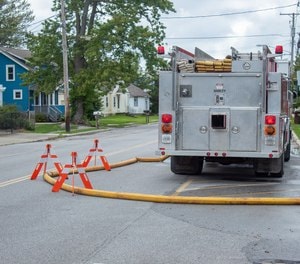 The Traffic Safety Cone Has Been In Use For Decades – Here's How It Got Reinvented
The Traffic Safety Cone Has Been In Use For Decades – Here's How It Got Reinvented -
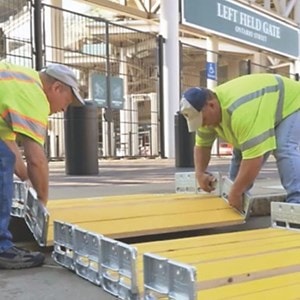 4 Ways a Portable Pedestrian Ramp Makes the Community more Accessible
4 Ways a Portable Pedestrian Ramp Makes the Community more AccessibleEveryone wants a more accessible community. But the reality is that all communities have unique obstacles that create barriers for those who do not have the same mobility abilities as others. For exam...
-
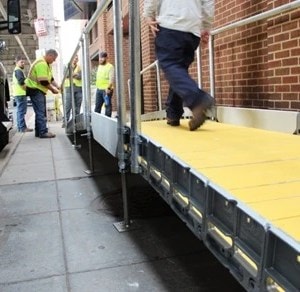 INNOVATIVE RAMP PROVIDES ACCESSIBILITY TO SIDEWALK OBSTRUCTION IN D.C. WORK ZONE
INNOVATIVE RAMP PROVIDES ACCESSIBILITY TO SIDEWALK OBSTRUCTION IN D.C. WORK ZONEA residential building in an area with heavy foot traffic needed maintenance, but the tools and machinery needed for the project created a tripping hazard. Closing the sidewalk was not an option so PS...